#wayag
Explore tagged Tumblr posts
Text

Wayag Island, Raja Ampat, Indonesia
2K notes
·
View notes
Note
AUGHW WAYAG I MISSED IT
Happy birthday !!!!
From stick bug anon
YOU DIDNT MISS IT DW, my birthday is on the 18th and I made that post right as it hit 12am here in my timezone so you aren't late dfsdfd THANK YOU STICK BUG ANON

#not a stick bug image I know criminal but its still funny#pov mama michaelis at your door step#mono ask
5 notes
·
View notes
Text
TURISIAN.com - Meski riak protes terhadap aktivitas tambang nikel di sebagian wilayah Raja Ampat belum surut, pemerintah menjamin kawasan wisata di kabupaten kepulauan itu tetap aman dikunjungi. Menteri Pariwisata Widiyanti Putri Wardhana angkat bicara merespons penutupan sementara akses ke Pulau Wayag dan Manyaifun Batangpele itu. Dua lokasi yang belakangan terseret polemik tambang. “Wisatawan tetap aman berkunjung ke Raja Ampat,” ujar Widiyanti dalam keterangan resmi Kementerian Pariwisata yang dirilis di Jakarta, Jumat 13 Juni 2025. Menurut dia, kementeriannya terus memantau perkembangan situasi dan siap mengambil langkah adaptif. Hal ini demi mendukung masyarakat lokal sebagai tulang punggung pembangunan pariwisata yang inklusif dan berdaya tahan. Penutupan Wayag dan Manyaifun bukan akhir dari pesona Raja Ampat. Sejumlah spot penyelaman kelas dunia seperti Manta Point, Cross Wreck, Cape Kri, hingga Blue Magic, tetap terbuka. Bahkan, menawarkan panorama bawah laut yang menggoda wisatawan dari seluruh dunia. Sementara itu, Pemerintah pusat, melalui Kementerian Dalam Negeri, telah menginstruksikan aparat daerah untuk menjaga keamanan wilayah wisata. Koordinasi juga dilakukan dengan aparat keamanan dan tokoh masyarakat setempat demi memastikan stabilitas dan kenyamanan pelancong. Raja Ampat, yang masuk dalam daftar destinasi prioritas nasional dan bagian dari jejaring UNESCO Global Geoparks, selama ini dikenal sebagai model pembangunan pariwisata berkelanjutan. Keseimbangan antara kelestarian ekologi, pertumbuhan ekonomi lokal, dan keberlanjutan budaya menjadi prinsip dasar pengelolaan kawasan ini. “Kami ingin menghadirkan pengalaman wisata yang aman, nyaman, dan berkelas dunia,” ujar Widiyanti. Ia menekankan pentingnya menjaga reputasi Raja Ampat sebagai ikon pariwisata unggulan Indonesia. ***
0 notes
Text
与鲸鲨共游:探秘鲜为人知的珊瑚礁秘境
乘坐12舱室的皮尼西帆船,在印度尼西亚Raja Ampat展开为期10天的巡游之旅,尽享浮潜、放松与美食盛宴。 清晨6点���,我乘着小艇冒险驶向Timor以西的一片海域,内心忐忑不安。与鲸鲨共游本应是一生难得的体验,但我已两次失之交臂。 或许印度尼西亚Raja Ampat的鲸鲨不会像西澳那般羞怯。 Raja Ampat的Wayag群岛植被茂密。Alamy 此刻,我正与十几位鲸鲨爱好者一同登上Ombak Putih号,开启这段梦幻之旅。这艘12舱室的传统木质皮尼西帆船虽比巴厘岛更靠近澳大利亚,但从墨尔本出发仍需近24小时航程。作为回报,我们将穿越一片拥有全球最壮丽却鲜有人至的珊瑚礁的群岛。 破晓时分,我们跃入水中。四头鲸鲨——三头成年和一头幼崽——正围绕着我们身旁起伏的bagan渔网游弋。 Raja Ampat壮观的珊瑚礁。Getty…

View On WordPress
0 notes
Text
Amanda Ketikidis - Hidden Paradise Destinations You Need to Visit
For travelers looking to escape the crowds and discover untouched beauty, these hidden paradise destinations offer breathtaking landscapes, unique experiences, and a sense of adventure. This post shared by Amanda Ketikidis.
1. Exuma, Bahamas 🏝️
Why Visit? Crystal-clear waters, deserted beaches, and swimming pigs!
Must-Do: Snorkel in Thunderball Grotto, visit Pig Beach, and explore the Exuma Cays by boat.
2. Koh Rong, Cambodia 🌊
Why Visit? A secluded island with powdery white sand and bioluminescent plankton.
Must-Do: Go night swimming to see glowing plankton, relax on Long Beach, and take a jungle trek.
3. Lofoten Islands, Norway ❄️
Why Visit? A mix of dramatic fjords, colorful fishing villages, and untouched Arctic beauty.
Must-Do: Hike to Reinebringen for jaw-dropping views, see the Northern Lights, and kayak through the fjords.
4. Fernando de Noronha, Brazil 🌴
Why Visit? A protected marine paradise with some of the world’s best beaches.
Must-Do: Snorkel with sea turtles at Baía do Sancho, hike to Mirante dos Golfinhos, and dive in clear waters.
5. Savai’i, Samoa 🌺
Why Visit? A peaceful Polynesian island with waterfalls, lava fields, and pristine beaches.
Must-Do: Swim in the Afu Aau Waterfall, visit Alofaaga Blowholes, and relax in a beachfront fale (hut).
6. Raja Ampat, Indonesia 🐠
Why Visit? An untouched paradise with the richest marine biodiversity on Earth.
Must-Do: Dive with manta rays, kayak through limestone islands, and visit the stunning Wayag viewpoint.
7. Kotor, Montenegro 🏰
Why Visit? A hidden gem in Europe with medieval charm and stunning fjord-like scenery.
Must-Do: Hike to the Fortress of San Giovanni, explore the Old Town, and take a boat trip to Our Lady of the Rocks.
8. Isla Holbox, Mexico 🌞
Why Visit? A car-free island with laid-back vibes, whale sharks, and stunning sunsets.
Must-Do: Swim with whale sharks (seasonal), see the bioluminescent beach, and relax in a hammock over the ocean.
9. Taveuni, Fiji 🌿
Why Visit? Known as the "Garden Island" with lush rainforests, waterfalls, and incredible reefs.
Must-Do: Hike to Bouma Falls, dive in Rainbow Reef, and cross the International Date Line.
10. Gili Meno, Indonesia 🏖️
Why Visit? A peaceful escape with white-sand beaches and an underwater sculpture park.
Must-Do: Snorkel with sea turtles, visit the Gili Meno Salt Lake, and enjoy a beachside sunset.
Would you like this list customized for Amanda Ketikidis' travel experiences or a specific audience? 😊
1 note
·
View note
Text

Raja Ampat: Surga Tersembunyi yang Menanti Penjelajahan
Temukan keajaiban alam Raja Ampat yang menakjubkan. Artikel ini membahas daya tarik wisata, keindahan laut, dan pengalaman tak terlupakan bagi wisatawan di BOS88.
BOS88: Keajaiban Alam yang Indah di Raja Ampat
Raja Ampat adalah salah satu destinasi wisata yang paling menakjubkan di Indonesia. Terkenal dengan keindahan alamnya, tempat ini menjadi surga bagi para wisatawan.
Mari jelajahi pesona alam yang ditawarkan oleh Raja Ampat dan temukan mengapa tempat ini layak dikunjungi.

Menemukan Keajaiban Alam Raja Ampat: Destinasi Impian Wisatawan
Di Raja Ampat, Anda akan disuguhi pemandangan laut yang jernih dan pulau-pulau kecil yang eksotis. Keberagaman hayati di bawah lautnya sangat memukau, menjadikannya tempat ideal untuk snorkeling dan diving.
Anda dapat menemukan berbagai spesies ikan dan terumbu karang yang menakjubkan.
Menyelami Keindahan Laut Raja Ampat yang Menakjubkan
Salah satu daya tarik utama Raja Ampat adalah Pulau Wayag. Pulau ini terkenal dengan pemandangan bukit karst yang dramatis. Dari puncaknya, Anda dapat menikmati panorama laut biru yang luas. Ini adalah lokasi yang sempurna untuk berfoto dan mengabadikan momen indah.
Untuk informasi lebih lanjut tentang Raja Ampat, Anda bisa mengunjungi Wonderful Indonesia atau Kompas Travel yang menyediakan panduan lengkap tentang destinasi ini.
1 note
·
View note
Text
The 5 stunning natural landscapes in Indonesia
The archipelago of over 17,000 islands is a treasure trove of breathtaking natural landscapes that captivate visitors from all over the world. From lush rain forests and towering volcanoes to pristine beaches and vibrant coral reefs, Indonesia's diverse geography has something for every nature enthusiast. The country's natural beauty is enhanced by its diverse wildlife, which includes iconic species such as the Komodo dragon and orangutans. Indonesia's landscapes are diverse and breathtaking, from the dramatic vistas of Komodo National Park to the underwater wonders of Raja Ampat and the serene beauty of Lake Toba. Each destination provides a unique experience, highlighting the country's natural beauty as well as the cultural heritage that thrives in these environments. Exploring Indonesia's landscapes takes you through some of the most remarkable and unspoiled regions on Earth.
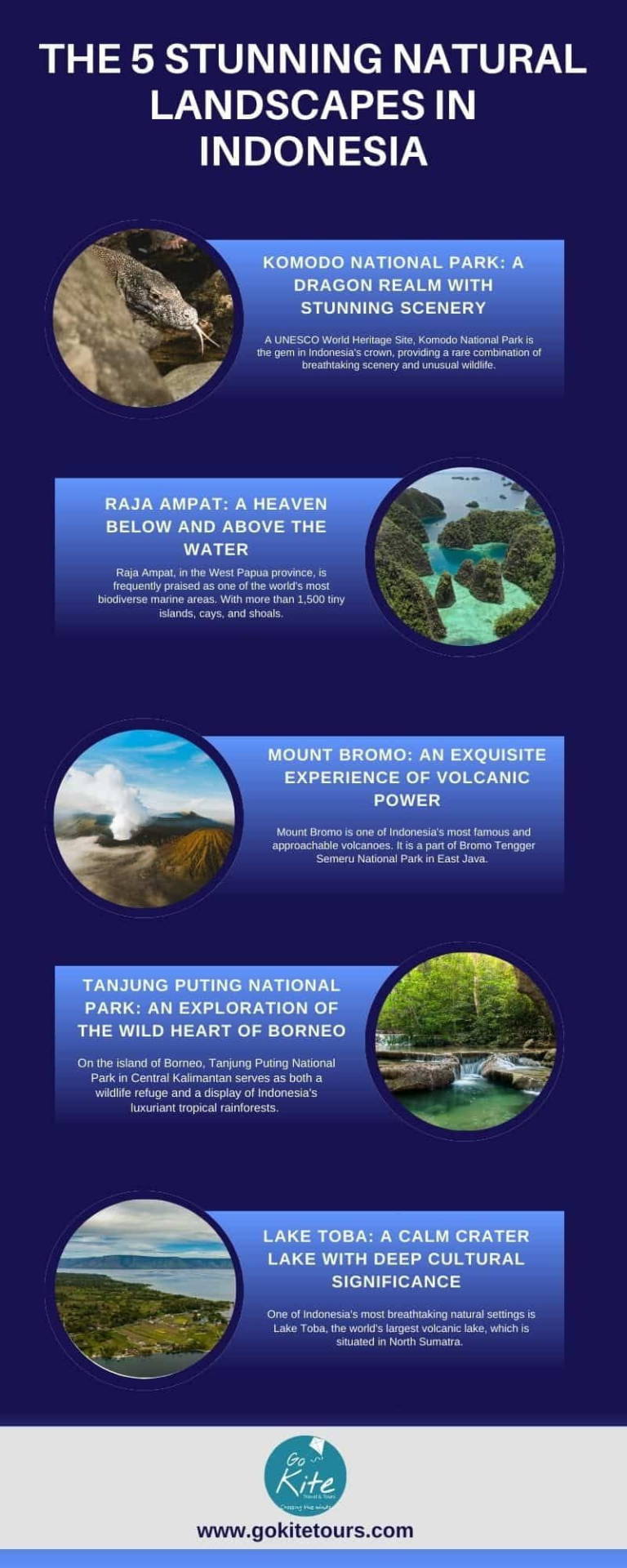
Here are some of the stunning natural landscapes in Indonesia.
1. Komodo National Park: A Dragon Realm with Stunning Scenery:

A UNESCO World Heritage Site, Komodo National Park is the gem in Indonesia's crown, providing a rare combination of breathtaking scenery and unusual wildlife. The largest lizards on Earth, the Komodo dragons, are the park's namesake and the reason it is spread across multiple islands. In addition to its amazing wildlife, the park features a striking combination of deep valleys, rocky hills, and immaculate beaches. Hiking in the park offers broad perspectives of the surrounding ocean, which is where the azure waves meet the blue sky. Not to be missed is the well-known Padar Island, with its breathtaking hills and beaches that change color. Komodo National Park is remarkable not only for its dragons but also for the unadulterated, unspoiled beauty of its surroundings.
2. Raja Ampat: A Heaven Below and Above the Water:

Raja Ampat, in the West Papua province, is frequently praised as one of the world's most biodiverse marine areas. With more than 1,500 tiny islands, cays, and shoals, this archipelago is a diver's paradise. The breathtaking coral reefs are teeming with marine life, providing an unparalleled underwater experience. However, Raja Ampat's splendor extends above and beyond the waves. With lush, green islands dotted throughout the azure sea, the scenery is just as captivating above water. Particularly the Wayag Islands, with their sharply rising karst formations from the sea, present a surreal sight. Discover undiscovered lagoons and beaches that resemble a little piece of paradise when you explore these islands by boat or kayak.
3. Mount Bromo: An Exquisite Experience of Volcanic Power:

Mount Bromo is one of Indonesia's most famous and approachable volcanoes. It is a part of Bromo Tengger Semeru National Park in East Java. The bizarre environment that envelops the volcano is truly unearthly. In order to see the sunrise over Bromo with the larger Semeru volcano and the foggy caldera in the background, visitors frequently drive or trek to the adjacent viewpoint atop Mount Penanjakan. A striking visual experience is produced by the contrast between the verdant mountain slopes and the desolate, ash-covered plain. Any visitor to Indonesia should see the smoldering crater of Mount Bromo, which is set against the enormous Sea of Sand. It is a testament to the unadulterated power of nature.
4. Tanjung Puting National Park: An Exploration of the Wild Heart of Borneo:
On the island of Borneo, Tanjung Puting National Park in Central Kalimantan serves as both a wildlife refuge and a display of Indonesia's luxuriant tropical rainforests. The best way to explore the park is on a klotok, a traditional riverboat that lets passengers glide through the Sekonyer River's murky waters while being encircled by thick jungle. Although the most well-known feature of Tanjung Puting is its orangutan population, gibbons, proboscis monkeys, and numerous bird species can also be found there. With its towering trees, thick undergrowth, and meandering rivers, the terrain provides a window into Borneo's wild interior.
5. Lake Toba: A Calm Crater Lake with Deep Cultural Significance:
One of Indonesia's most breathtaking natural settings is Lake Toba, the world's largest volcanic lake, which is situated in North Sumatra. The lake is a serene, breathtaking location that was created by a supervolcanic eruption some 74,000 years ago. The steep, wooded hills that encircle Lake Toba's deep blue waters create a stunning, almost mystical scene. Samosir Island, the cultural center of the Batak people, is located in the middle of the lake. Discover traditional villages, historic stone tombs, and characteristic Batak architecture here. When compared to other places with more rugged landscapes, Lake Toba's serene atmosphere and rich cultural heritage provide a tranquil haven.
Conclusion:
Exploring the stunning natural landscapes of Indonesia is an unforgettable journey that reveals the immense beauty and diversity of this island nation. From the rugged terrains of Komodo National Park to the serene waters of Lake Toba, each landscape offers a unique glimpse into Indonesia’s rich natural heritage. Whether you're trekking through volcanic craters, diving into vibrant coral reefs, or cruising along jungle rivers, these experiences are a testament to the country’s unparalleled allure. To fully appreciate these wonders, securing an Indonesia visa is the first step in your adventure. The visa process is straightforward, allowing travelers to immerse themselves in Indonesia’s breathtaking environments without hassle. Whether you’re drawn to the islands’ dramatic scenery or their serene, peaceful retreats, Indonesia promises an experience of nature at its most pristine, making it a must-visit destination for nature enthusiasts and adventure seekers alike.
0 notes
Text
Saturday, August 16 - At Sea
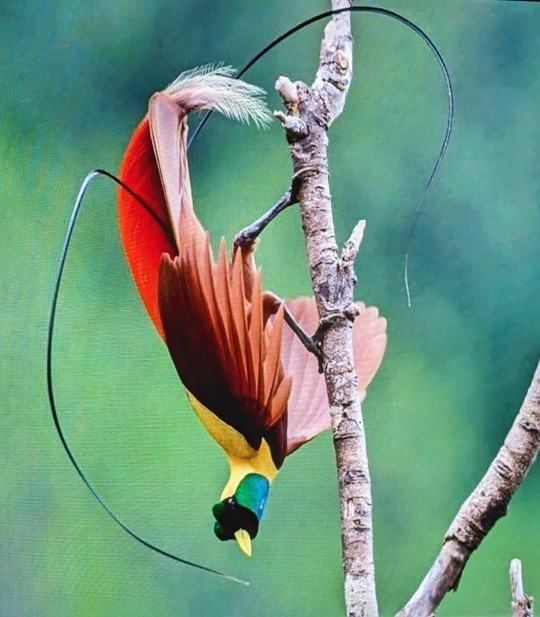
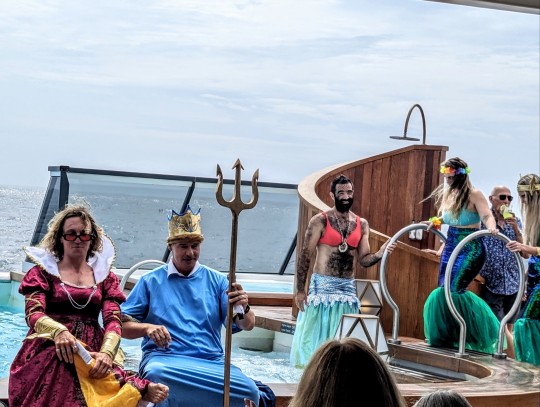

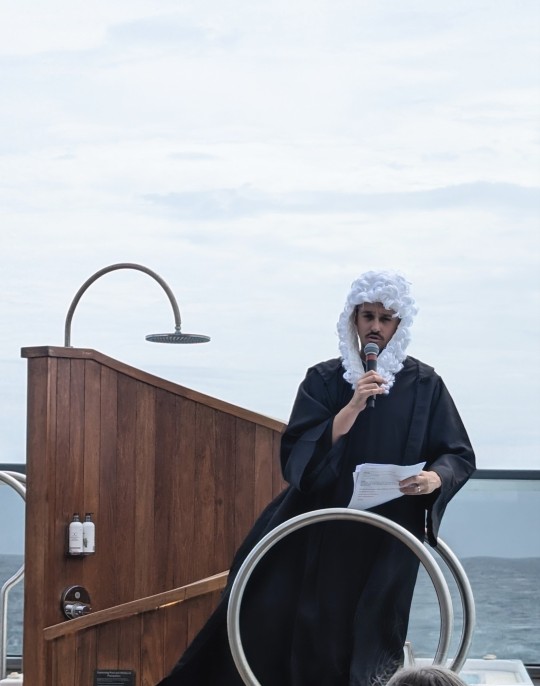
After three very busy days, it was great to have a chance just to sit back and relax and have some fun. (And also take in a few lectures). The morning started cloudy and rainy, and we had doubts that the "Crossing the Equator" ceremony would even take place. We actually have crossed that imaginary line (although our Cruise Director swears he heard the "bump" when we hit it) twice - going to and returning from our wonderful day at Wayag. Because those days were so jam-packed full of other activities, the ceremony was put off until a sea day.
The ceremony (and this is the third I've witnessed) is a ritual on all ships for those who have never crossed the equator by ship, as the "pollywogs" (never have crossed) become "shellbacks" (have crossed at least once). Every ceremony is different, but all seem to include a visit from King Neptune, being sentenced in a "court", kissing a fish, and being dunked in the pool, usually after being slimed with something. It's always great fun, with the crew and expedition staff getting to dress up in a variety of costumes (mermaids, pirates, etc.) and the willing participants (victims) being good sports about it.
The sun came out at lunchtime and by the time of the ceremony it was nice and warm, so it wasn't so awful to have to have a swim. Our Cruise Director, Lupi, was the judge, and called out the "crimes", our Hotel Manager, Guy was King Neptune, and Harry, our photographer on the last segment and an expedition crew member on this one, was King Neptune's wife (he has the hair for it)! Several of the "mermaids" had suspiciously hairy chests. We will have two more equator crossings on this trip in two more different segments, so we'll get to see other versions before we are done.
The last picture is not mine, but taken from a slide in a presentation on Birds-of-Paradise, given by Joe, one of the ornithologists on board. This is the bird that we were lucky enough to see on our hike, and really shows off the extravagant feathers. I have pictures of all the parts of the bird, taken from different angles, but not the whole bird like this - it's a great photo. The Birds-of-Paradise are a large family, and some have even more exuberant feathers than these. They tend to gather in a lek, like our sage-grouse, where the males "strut" their stuff in front of the females, trying to outdo one another. Our hike was to a known lek site, but we were lucky to see them in the afternoon.
Tomorrow we are visiting a village near Agats, on the New Guinea mainland, and will caravan in with our Zodiacs and up a small river. Because of logistics, we all need to get into a Zodiac before setting off together, and it could be a long morning before we arrive, as it is 8 miles across open ocean to the river. We have been told it will be a cultural experience like none we may have had before, and we are looking forward to it, although the weather forecast is for rain. But then again, when are the weather forecasters correct?
0 notes
Text
View of Wayag Rock Islands, West Papua, Indonesia
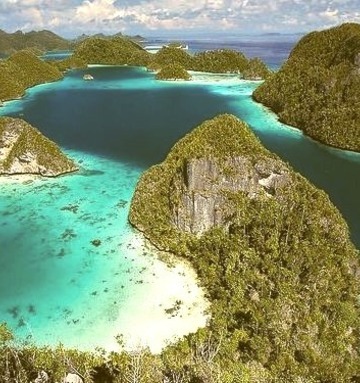
0 notes
Text
Wayag, Raja Ampat, West Papua
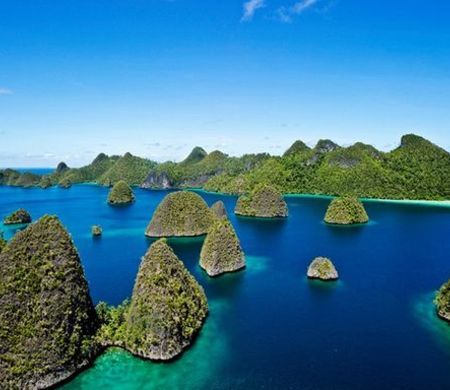
Unlock the true essence of paradise as you set foot in Wayag, a hidden gem tucked away in Raja Ampat, West Papua. Get ready for an adventure of a lifetime.
0 notes
Text
Archipelago Wayag, Raja Ampat
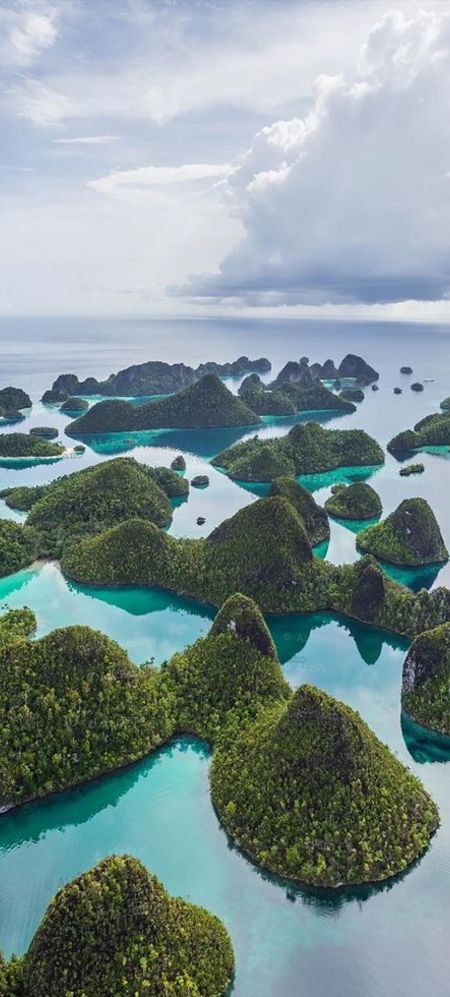
Immerse yourself in the untouched splendor of Archipelago Wayag, Raja Ampat. Explore the vibrant marine life, hike the hills, and cherish moments of pure tranquility.
0 notes
Text
Archipelago Wayag, Raja Ampat
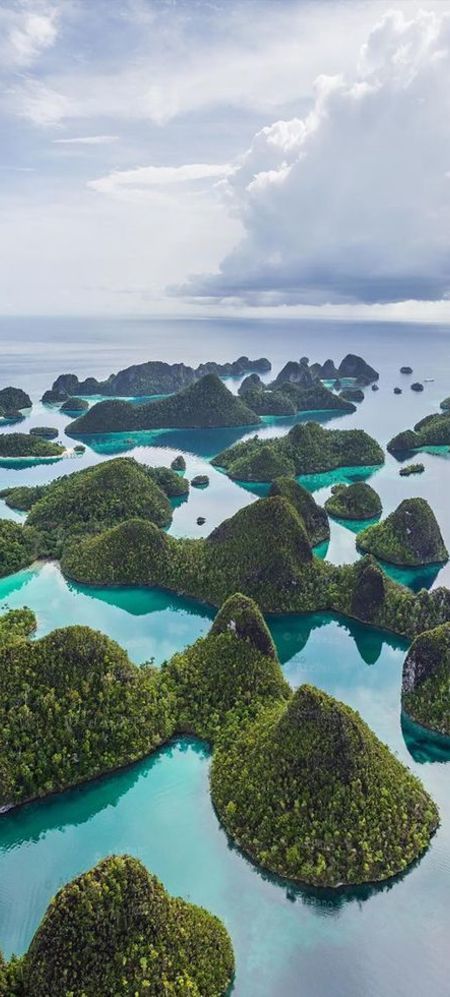
Immerse yourself in the untouched splendor of Archipelago Wayag, Raja Ampat. Explore the vibrant marine life, hike the hills, and cherish moments of pure tranquility.
0 notes
Text
TURISIAN.com - Asosiasi Pengusaha Wisata Selam Indonesia (Indonesia Divetourism Company Association/IDCA) mendesak Presiden Prabowo Subianto. Mereka minta Presiden segera mencabut secara permanen izin pertambangan di kawasan Raja Ampat, Papua Barat Daya. Aktivitas tambang nikel yang belakangan muncul dinilai menjadi ancaman serius terhadap masa depan wisata bahari kelas dunia di wilayah tersebut. “Kami meminta Presiden memerintahkan pencabutan permanen, bukan sekadar penangguhan sementara,” ujar Ketua Umum IDCA, Ebram Harimurti, dalam surat terbuka, kemarin. Surat terbuka bernomor 001/EXT/IDCA/VI/2025 itu bertajuk Perlindungan Kawasan Raja Ampat dari Ancaman Tambang Nikel. Menurut Ebram, aktivitas tambang berada di wilayah penyangga sekitar Pulau Kawe dan Wayag. Zona yang mencakup jalur migrasi satwa laut, termasuk manta ray di Eagle Rock. “Tumpukan sedimen dari tambang bisa terbawa arus laut dan merusak terumbu karang serta mengancam habitat laut penting,” katanya. Ebram tak menampik bahwa lokasi tambang tidak berada di inti kawasan perlindungan. Namun, ia mengingatkan dampaknya tak bisa diremehkan. Lumpur tambang yang menutupi sinar matahari bawah laut berisiko menghancurkan ekosistem. “Fakta ini sangat mengerikan bagi pelaku wisata alam. Bayangkan jika kami harus menjelaskan ini kepada wisatawan internasional yang mengagungkan Raja Ampat sebagai The World Class Diving Site in the Coral Triangle,” paparnya. Reputasi di Ujung Tanduk Dalam kacamata pelaku wisata, aktivitas pertambangan bukan hanya persoalan lingkungan, tapi juga reputasi. “Indonesia bisa kehilangan muka di mata dunia. Ini bukan sekadar debat soal ekonomi, ini soal jati diri bangsa yang menjual keindahan alamnya sebagai kekuatan pariwisata,” kata Ebram. Ia memahami bahwa pembangunan nasional menuntut pendekatan multisektor. Namun, menurutnya, tidak semua wilayah cocok untuk ditambang. “Ini momentum untuk menunjukkan bahwa Indonesia bisa menyelaraskan kepentingan industri dengan konservasi. Harus ada solusi menang-menang.” IDCA pun mendesak pemerintah memperluas zona larangan (no take zone) dan zona penyangga (buffer zone) di antara Pulau Kawe dan Wayag. Selain itu, mereka menuntut penguatan penegakan hukum atas zonasi konservasi yang melarang segala bentuk aktivitas ekstraktif. Dorongan pada Ekowisata dan Ekonomi Hijau IDCA juga menyoroti potensi ekonomi lain: ekowisata. Mereka mendorong pemerintah memperkuat ekonomi hijau berbasis masyarakat lokal, nelayan, dan komunitas adat. “Libatkan masyarakat dalam pengawasan kawasan. Jangan biarkan pembangunan berjalan tanpa inklusivitas,” kata Ebram. Ia meyakini, pembangunan sejati tidak boleh mengorbankan aset alam dan budaya yang tak tergantikan. “Ini momentum bagi Indonesia untuk menunjukkan kepemimpinan dalam pembangunan hijau yang adil dan lestari.” Wisata Alam, Andalan Pariwisata Nasional Ebram mengutip data Kementerian Pariwisata yang menunjukkan bahwa lebih dari 60 persen daya tarik wisata Indonesia bersumber dari alam. “Pariwisata nasional bertumpu pada kelestarian alam. Mengorbankan itu sama saja dengan memotong dahan tempat kita berteduh.” Ia menambahkan, studi UNDP dan BRIN pada 2021 menunjukkan bahwa pendekatan konservasi berbasis masyarakat terbukti memberikan manfaat ekonomi nyata tanpa merusak lingkungan. Pada 2024, sedikitnya 30 ribu wisatawan mengunjungi Raja Ampat. Sekitar 70 persen di antaranya merupakan turis mancanegara yang menyumbang lebih dari Rp150 miliar untuk Pendapatan Asli Daerah Kabupaten Raja Ampat. “Nilai ekonomi ini hanya permukaan. Jauh di bawahnya ada ekosistem yang menopang ekonomi lokal dalam jangka panjang.” Papua, sejak 2018, telah ditetapkan sebagai provinsi konservasi berdasarkan komitmen para gubernurnya. Maka, pembangunan di wilayah ini seharusnya tunduk pada prinsip-prinsip konservasi dan keberlanjutan. Berdasarkan data UPTD BLUD Pengelolaan Kawasan Perairan Raja Ampat, luas kawasan konservasi di wilayah ini mencapai 2.
000.109 hektare. Yakni, mencakup tujuh zona perlindungan, termasuk Selat Dampier, Misool, Kepulauan Ayau-Asia, dan Fam. “Raja Ampat bukan sekadar kebanggaan nasional. Ia simbol konservasi laut dunia. Menempatkan tambang nikel di tengah-tengahnya adalah bentuk kontradiksi yang tidak bisa ditoleransi,” kata Ebram. ***
0 notes
Photo

Wayag, Raja Ampat, West Papua Unleash your wanderlust and conquer the breathtaking beauty of Wayag in Raja Ampat, West Papua. Prepare to be amazed.
0 notes
Text
View of Wayag Rock Islands, West Papua, Indonesia

0 notes
Photo
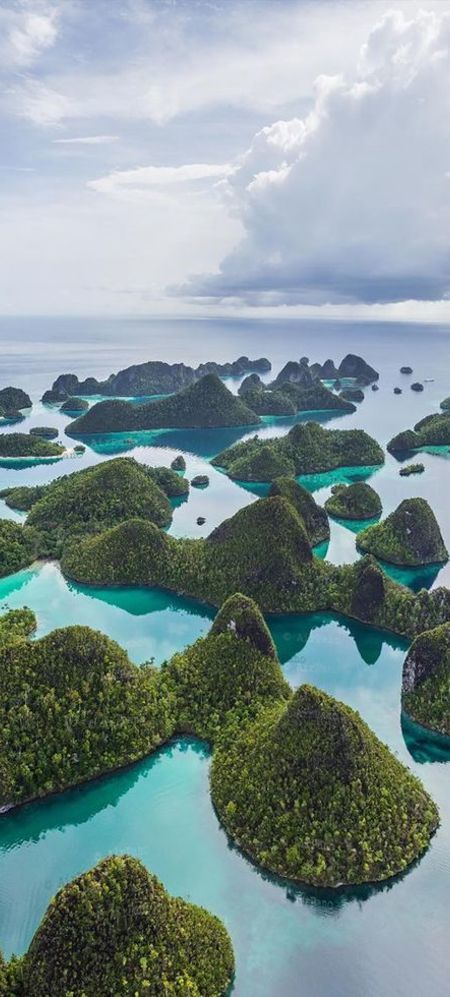
Archipelago Wayag, Raja Ampat Immerse yourself in the untouched splendor of Archipelago Wayag, Raja Ampat. Explore the vibrant marine life, hike the hills, and cherish moments of pure tranquility.
0 notes